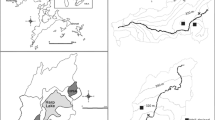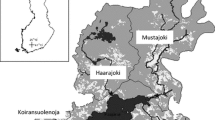Abstract
Mechanisms underlying catchment export of nitrogen (N) during seasonal transitions (i.e., winter to spring and summer to autumn) were investigated in high-elevation catchments of the Sierra Nevada using stable isotopes of nitrate and water, intensive monitoring of stream chemistry and detailed catchment N-budgets. We had four objectives: (1) determine the relative contribution of snowpack and soil nitrate to the spring nitrate pulse, (2) look for evidence of biotic control of N losses at the catchment scale, (3) examine dissolved organic nitrogen ( DON) export patterns to gain a better understanding of the biological and hydrological controls on DON loss, and (4) examine the relationship between soil physico-chemical conditions and N export. At the Emerald Lake watershed, nitrogen budgets and isotopic analyses of the spring nitrate pulse indicate that 50 to 70% of the total nitrate exported during snowmelt (ca. April to July) is derived from catchment soils and talus; the remainder is snowpack nitrate. The spring nitrate pulse occurred several weeks after the start of snowmelt and was different from export patterns of less biologically labile compounds such as silica and DON suggesting that: (1) nitrate is produced and released from soils only after intense flushing has occurred and (2) a microbial N-sink is operating in catchment soils during the early stages of snowmelt. DON concentrations varied less than 20–30% during snowmelt, indicating that soil processes tightly controlled DON losses.
Similar content being viewed by others
References
Bales R.C., Davis R.E. and Stanley D.A. 1989. Ion elution through shallow homogeneous snow. Water Resources Research 25: 1869–1877.
Bales R.C., Davis R.E. and Williams M.W. 1993. Tracer release in melting snow – diurnal and seasonal patterns. Hydrological Processes 7: 389–401.
Bales R.C., Sommerfeld R.A. and Kebler D.G. 1990. Ionic tracer movement through a Wyoming snowpack. Atmospheric Environment 24: 2749–2758.
Bilbrough C.J., Welker J.M. and Bowmann W.D. 2000. Early spring nitrogen uptake by snow-covered plants: A comparison of arctic and alpine plant function under the snowpack. Arctic and Alpine Research 32: 404–411.
Brooks P.D., McKnight D.M. and Bencala K.E. 1999. The relationship between soil heterotrophic activity, soil dissolved organic carbon (DOC) leachate, and catchment-scale DOC export in headwater catchments. Water Resources Research 35: 1895–1902.
Brooks P.D., Schmidt S.K. and Williams M.W. 1997. Winter production of CO2 and N2O from Alpine tundra: Environmental controls and relationship to inter-system C and N fluxes. Oecologia 110: 403–413.
Brooks P.D. and Williams M.W. 1999. Snowpack controls on nitrogen cycling and export in seasonally snow-covered catchments. Hydrological Processes 13: 2177–2190.
Brooks P.D., Williams M.W. and Schmidt S.K. 1996. Microbial activity under alpine snowpacks, Niwot Ridge, Colorado. Biogeochemistry 32: 93–113.
Brooks P.D., Williams M.W. and Schmidt S.K. 1998. Inorganic nitrogen and microbial biomass dynamics before and during spring snowmelt. Biogeochemistry 43: 1–15.
Burns D.A., Murdoch P.S., Lawrence G.B. and Michel R.L. 1998. Effect of groundwater springs on NO3 concentrations during summer in Catskill Mountain streams. Water Resources Research 34: 1987–1996.
Campbell D.H., Baron J.S., Tonnessen K.A., Brooks P.D. and Schuster P.F. 2000. Controls on nitrogen flux in alpine/subalpine watersheds of Colorado. Water Resources Research 36: 37–47.
Campbell D.H., Clow D.W., Ingersoll G.P., Mast M.A., Spahr N.E. and Turk J.T. 1995. Processes controlling the chemistry of two snowmelt-dominated streams in the Rocky Mountains. Water Resources Research 31: 2811–2821.
Campbell D.H., Kendall C., Chang C.C.Y., Silva S.R. and Tonnessen K.A. 2002. Pathways for nitrate release from an alpine watershed: Determination using δ15N and 18O. Water Resources Research, DOI 10.1029/2001WR000294.
Campbell J.L., Hornbeck J.W., McDowell W.H., Buso D.C., Shanley J.B. and Likens G.E. 2000. Dissolved organic nitrogen budgets for upland, forested ecosystems in New England. Biogeochemistry 49: 123–142.
Chang C.C.Y., Langston J., Riggs M., Campbell D.H., Silva S.R. and Kendall C. 1999. A method for nitrate collection for delta N-15 and delta O-18 analysis from waters with low nitrate concentrations. Canadian Journal of Fisheries and Aquatic Sciences 56: 1856–1864.
Clein J.S. and Schimel J.P. 1995. Microbial activity of tundra and taiga soils at sub-zero temperatures. Soil Biology & Biochemistry 27: 1231–1234.
Clow D.W., Mast M.A. and Campbell D.H. 1996. Controls on surface water chemistry in the Upper Merced River Basin, Yosemite National Park. California. Hydrological Processes 10: 727–746.
Creed I.F. and Band L.E. 1998. Export of nitrogen from catchments within a temperate forest: Evidence for a unifying mechanism regulated by variable source area dynamics. Water Resources Research 34: 3105–3120.
Del Grosso S.J., Parton W.J., Mosier A.R., Ojima D.S., Kulmala A.E. and Phongpan S. 2000. General model for N2O and N2 gas emissions from soils due to denitrification. Global Biogeochemical Cycles 14: 1045–1060.
Feller G., Narinx E., Arpigny J.L., Aittaleb M., Baise E., Genicot S. et al. 1996. Enzymes from psychrophilic organisms. Fems Microbiology Reviews 18: 189–202.
Hedin L.O., Armesto J.J. and Johnson A.H. 1995. Patterns of nutrient loss from unpolluted, old-growth, temperate forests: Evaluation of biogeochemical theory. Ecology 76: 493–509.
Jaeger C.H., Monson R.K., Fisk M.C. and Schmidt S.K. 1999. Seasonal partitioning of nitrogen by plants and soil microorganisms in an alpine ecosystem. Ecology 80: 1883–1891.
Kattelmann R. and Elder K. 1991. Hydrologic characteristics and water balance of an alpine basin in the Sierra Nevada. Water Resour. Res. 27: 1553–1562.
Kendall C. 1998. Tracing nitrogen sources and cycles in catchments. In: Kendall C. and McDonnell J.J. (eds), Isotope Tracers in Catchment Hydrology. Elsevier Science, Amsterdam, The Netherlands, pp. 519–576.
Kendall C., Campbell D.H., Burns D.A., Shanley J.B., Silva S.R. and Chang C.C.Y. 1995. Tracing sources of nitrate in snowmelt runoff using the oxygen and nitrogen isotopic compositions of nitrate. In: Tonnessen K.A., Williams M.W. and Tranter M. (eds), Biogeochemistry of Seasonally Snow-Covered Catchments. IAHS Publication no, 228, pp. 339–347.
Leydecker A. and Melack J.M. 1999. Evaporation from snow in the central Sierra Nevada of California. Nordic Hydrology 30: 81–108.
Leydecker A., Sickman J.O. and Melack J.M. 1999. Episodic lake acidification in the Sierra Nevada, California. Water Resources Research 35: 2793–2804.
Lipson D.A. and Monson R.K. 1998. Plant-microbe competition for soil amino acids in the alpine tundra: effects of freeze-thaw and dry-rewet events. Oecologia 113: 406–414.
Lipson D.A., Raab T.K., Schmidt S.K. and Monson R.K. 1999. Variation in competitive abilities of plants and microbes for specific amino acids. Biology and Fertility of Soils 29: 257–261.
Lipson D.A., Schmidt S.K. and Monson R.K. 2000. Carbon availability and temperature control the post-snowmelt decline in alpine soil microbial biomass. Soil Biology & Biochemistry 32: 441–448.
Meixner T. and Bales R.C. 2003. Integrated hydrologic and carbon-nitrogen modeling of an alpine ecosystem, importance of snow cover. Biogeochemistry 62: 289–308.
Melack J.M., Sickman J.O. and Leydecker A. 1998. Comparative analyses of high-altitude lakes and catchments in the Sierra Nevada: Susceptibility to acidification. Final report, contract A032–188. California Environmental Protection Agency, Air Resources Board, Research Division, 598 pp.
Oliver G.B., Thurman E.M. and Malcolm R.L. 1983. The contribution of humic substances to the acidity of colored natural waters. Geochimica et Cosmochimica Acta 47: 2031–2035.
Schimel J.P. and Clein J.S. 1996. Microbial response to freeze-thaw cycles in tundra and taiga soils. Soil Biology & Biochemistry 28: 1061–1066.
Sickman J.O., Leydecker A. and Melack J.M. 2001. Nitrogen mass balances and abiotic controls on N retention and yield in high-elevation catchments of the Sierra Nevada, California, United States. Water Resources Research 37: 1445–1461.
Sickman J.O. and Melack J.M. 1998. Nitrogen and sulfate export from high elevation catchments of the Sierra Nevada, California. Water Air and Soil Pollution 105: 217–226.
Sickman J.O., Melack J.M. and Stoddard J.L. 2002. Regional analysis of inorganic nitrogen yield and retention in high-elevation ecosystems of the Sierra Nevada and Rocky Mountains. Biogeochemistry 57/58: 341–374.
Sofer Z. and Gat J.R. 1972. Activities and concentrations of oxygen-18 in concentrated aqueous salt solutions: analytical and geophysical implications. Earth Planet. Sci. Letters 15: 232–238.
Solomon D.K. and Cerling T.E. 1987. The annual carbon dioxide cycle in a montane soil: observations, modeling and implications for weathering. Water Resources Research 23: 2257–2265.
Stepanauskas R., Laudon H. and Jorgensen N.O.G. 2000. High DON bioavailability in boreal streams during a spring flood. Limnology and Oceanography 45: 1298–1307.
Stottlemyer R. 1992. Nitrogen mineralization and streamwater chemistry, Rock Creek watershed, Denali National Park, Alaska, USA. Arctic and Alpine Research 24: 291–303.
Stottlemyer R. and Toczydlowski D. 1996. Precipitation, snowpack, stream-water ion chemistry, and flux in a northern Michigan watershed, 1982–1991. Canadian Journal of Fisheries and Aquatic Sciences 53: 2659–2672.
Strickland J.D. and Parsons T.R. 1972. A Practical Handbook of Seawater Analysis. Bull. Fish. Res. Bd. Can.
Valderrama J.C. 1981. The simultaneous analysis of total nitrogen and total phosphorus in natural waters. Marine Chemistry 10: 109–122.
Vitousek P.M. and Field C.B. 1999. Ecosystem constraints to symbiotic nitrogen fixers: a simple model and its implications. Biogeochemistry 46: 179–202.
Vitousek P.M., Hedin L.O., Matson P.A., Fownes J.H. and Neff J.C. 1998. Within-system element cycles, input-output budgets and nutrient limitation. In: Groffman P.M. and Pace M.L. (eds), Successes, Limitation and Frontiers in Ecosystem Science. Springer, New York, NY, USA, pp. 432–451.
Williams M.W., Bales R.C., Brown A.D. and Melack J.M. 1995. Fluxes and transformations of nitrogen in a high-elevation catchment, Sierra Nevada. Biogeochemistry 28: 1–31.
Williams M.W., Brooks P.D., Mosier A. and Tonnessen K.A. 1996. Mineral nitrogen transformations in and under seasonal snow in a high-elevation catchment in the Rocky Mountains, United States. Water Resources Research 32: 3161–3171.
Williams M.W., Brooks P.D. and Seastedt T. 1998. Nitrogen and carbon soil dynamics in response to climate change in a high-elevation ecosystem in the Rocky Mountains, USA. Arctic and Alpine Research 30: 26–30.
Williams M.W., Brown A.D. and Melack J.M. 1993. Geochemical and hydrologic controls on the composition of surface water in a high-elevation basin, Sierra-Nevada, California. Limnology and Oceanography 38: 775–797.
Williams M.W., Hood E. and Caine N. 2001. The role of organic nitrogen in the nitrogen cycle of a high-elevation catchment, Colorado Front Range, USA. Water Resources Research 37: 2569–2581.
Williams M.W. and Melack J.M. 1991a. Solute chemistry of snowmelt and runoff in an alpine basin, Sierra Nevada. Water Resources Research 27: 1575–1588.
Williams M.W. and Melack J.M. 1991b. Precipitation chemistry in and ionic loading to an alpine basin, Sierra Nevada. Water Resources Research 27: 1563–1574.
Rights and permissions
About this article
Cite this article
Sickman, J.O., Leydecker, A., Chang, C.C. et al. Mechanisms underlying export of N from high-elevation catchments during seasonal transitions. Biogeochemistry 64, 1–24 (2003). https://doi.org/10.1023/A:1024928317057
Issue Date:
DOI: https://doi.org/10.1023/A:1024928317057




